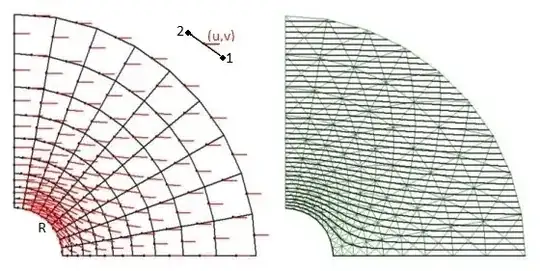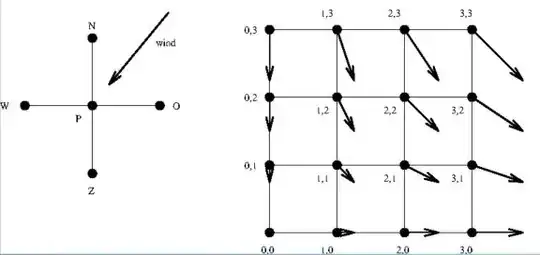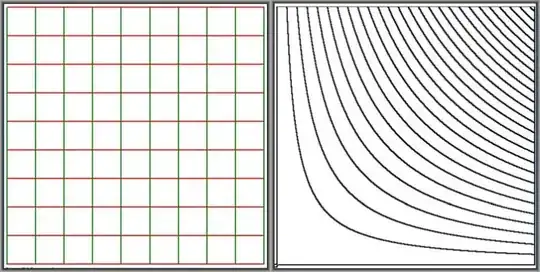Say I have a given numerical velocity field in two dimensions, (u,v). I am trying to find the streamlines from this data set at a particular contour level and I thus have to solve the differential equation
$$
dy/dx = v/u=g(x,y)
$$
I can rewrite the equation to
$$
dy = g(x_i,y_i)dx
$$
The subscript $i$ denotes that $g$ is given at discrete points. Do I solve this equation simply by choosing a $y_i$ and then summing for all $x_i$?
- 730
-
3You're over-complicating. $dy/dx=v/u$ is a perfectly good ODE describing the streamlines. It fails if $u=0$ anywhere though, so you solve for the $y$ and $x$ components separately: $dy/dt=v$ and $dx/dt=u$. – David Sep 20 '16 at 23:35
-
1@David Thanks. So I multiply by $dt$ and get $dy=vdt$ that I can integrate. How do I integrate this equation, given that my velocity field is discrete? I can use forward Euler, but would I need to interpolate the equation when it is not at grid points? – BillyJean Sep 30 '16 at 13:15
-
1@David Maybe it is easier for me to get the streamlines from the streamfunction? Then I would have to integrate the velocity-field, but I'm not sure how to do that either – BillyJean Sep 30 '16 at 13:44
-
1Yeah, interpolate from your data points. It can be messy, but it's really the only option. Make a lot of sort streamlines rather than fewer long ones to reduce the error. – David Sep 30 '16 at 19:57
-
@David Thanks. Do you know how I can get a streamfunction from the velocity field? – BillyJean Oct 01 '16 at 07:41
-
2@David: Really the only option? I think the answer below shows that you're not quite right. – Han de Bruijn Oct 08 '16 at 19:19
-
Which of the questions in this list still needs an answer? – Han de Bruijn Oct 08 '16 at 19:23
2 Answers
The BONUS part in the following answer shall be used as a template:
The given numerical velocity field from that template is displayed here again for convenience:There are many roads to Rome. Talking about a given numerical velocity field, what do you mean? Among the many possibilities, there is a rectangular grid $(i,j)$ with velocities $(u,v)$ given at the vertices of the rectangles in the grid. Using ideal flow in a corner as the template, then we have for coordinates $(x,y)$ and velocities (see picture below): $$ x = i \quad ; \quad y = j \quad ; \quad u = x \quad ; \quad v = -y $$ The stream function $\psi(x,y)$ in general can be calculated with: $$ \color{red}{\frac{\partial \psi}{\partial x} = -v} \quad ; \quad \color{green}{\frac{\partial \psi}{\partial y} = +u} $$ Colors indicate that $\color{red}{horizontal}$ line segments shall be used for discretization of the first equation and $\color{green}{vertical}$ line segments shall be used for discretization of the second equation: $$ \color{red}{\psi_{i+1,j}-\psi_{i,j} = -j} \quad ; \quad \color{green}{\psi_{i,j+1}-\psi_{i,j} = +i} $$ Resulting in an overdetermined system of linear equations: $M$ equations with $N$ unknowns, where in our case
const grid : integer = 10; N := grid\*grid; M := 2\*(grid-1)\*grid;
The overdetermined equations are stored in a $M\times N$ matrix $\,A\,$ and a vector $\,r\,$ with length $M$ .
Note that $\,0 \le i,j \le \mbox{grid}-1$ .
With help of a function $\;\operatorname{nr}(i,j) = j\times\mbox{grid}+i\;$ we have:
$$
A_{k,\operatorname{nr}(i,j)} = -1 \quad \mbox{and} \quad
\begin{cases}
\color{red}{A_{k,\operatorname{nr}(i+1,j)} = +1} & \color{red}{r_k = -j} \\
\color{green}{A_{k,\operatorname{nr}(i,j+1)} = +1} & \color{green}{r_k = +i}
\end{cases}
$$
These equations can be assembled in a Least Squares (Finite Element) sense. Ipse est (i.e.) form the system matrix $\,S\,$ and the load vector $\,b\,$ by:
$$
S = A^T A \quad ; \quad b = A^T r
$$
Oh yeah, and don't forget to impose a boundary condition on the stream function somewhere. I did it at
$\;\psi(\operatorname{nr}(0,\mbox{grid}-1)=0$ , by making the corresponding system matrix main diagonal element really BIG.
Now solve the equations $S\psi = b$ . Then what we get is a discretized stream function $\,\psi(x,y)$ .
The isolines of $\,\psi\,$ are the streamlines and can be plotted as shown in the above picture on the right. A bilinear interpolation at the rectangles in the grid is being employed for that purpose.
The software accomplishing all this is available for free, but it is far from optimal : take a look at
MSE publications / references in 2016 . I hope you can generalize for your own purpose where such is needed. But again, there are many roads that lead to Rome, especially in Numerical Analysis.
Update. In view of a comment by the OP:
$$
\color{red}{\frac{\partial \psi}{\partial x} = -v} \quad ; \quad \color{green}{\frac{\partial \psi}{\partial y} = +u}
\quad \Longrightarrow \\ d\psi = -v\,dx + u\,dy \quad \Longrightarrow \quad
\int_{(1)}^{(2)} d\psi = -\int_{(1)}^{(2)}v\, dx + \int_{(1)}^{(2)}u\, dy
\quad \Longrightarrow \\ \psi_2-\psi_1 \approx -\frac{v_1+v_2}{2}(x_2-x_1) + \frac{u_1+u_2}{2}(y_2-y_1) = (\vec{w_1}+\vec{w_2})/2 \times (\vec{r_2}-\vec{r_1})
$$
with $\,\vec{w} = (u,v)\,$ and $\,\vec{r} = (x,y)$ , interpreted physically as a discretized flux through a 1-D area.
An advantage of the latter formulation is that line segment( element)s no longer need to be vertical or horizontal.
This may be more appropriate with numerical methods that are Finite Element like.
Least Squares method. In case it needs a bit of explanation.
The system of overdetermined equations ($A\psi-r$) is squared, summed and minimized:
$$
(A\psi-r,A\psi-r) = \sum_{k=1}^M \left( \sum_{i=1}^N A_{ki} \psi_i - r_k \right)^2 = \,\operatorname{minimum}(\psi)
$$
By differentiating to $\,\psi_i\,$ we get $N$ (symmetric) equations with $N$ unknowns $S \psi = b$ :
$\partial/\partial \psi_i\, \operatorname{minimum}(\psi) =$
$$
2\sum_{k=1}^M A_{ki} \left( \sum_{j=1}^N A_{kj} \psi_j - r_k \right) = 0 \quad \Longrightarrow \\ \sum_{j=1}^N
\underbrace{\sum_{k=1}^M A_{ki} A_{kj}}_{\large S_{ij}}\, \psi_j = \underbrace{\sum_{k=1}^M A_{ki} r_k}_{\large b_i}
$$
Taking one step backwards, the integral form of the Least Squares (Finite Element) method is:
$$
\iint \left[\left(\frac{\partial \psi}{\partial x} + v \right)^2
+ \left(\frac{\partial \psi}{\partial y} - u \right)^2\right] dx\, dy = \mbox{minimum}(\psi)
$$
According to
calculus of variations
(or boldly differentiating to $\psi$ and discarding the integral signs):
$$
\frac{\partial}{\partial x}\left(\frac{\partial \psi}{\partial x} + v\right) +
\frac{\partial}{\partial y}\left(\frac{\partial \psi}{\partial y} - u\right) = 0
$$ $$
\frac{\partial^2 \psi}{\partial x^2} + \frac{\partial^2 \psi}{\partial y^2} =
- \omega \quad \mbox{with} \quad
\omega = \frac{\partial v}{\partial x} - \frac{\partial u}{\partial y}
$$
Which is recognized as Poisson's equation for the streamfunction, with vorticity on the right hand side.
This means that among the several roads to Rome there is a great chance that some of these are equivalent
with the method as presented in this answer. One advantage being that there is no numerical differentiation needed for calculating the vorticity.
- 17,070
-
Thanks, that is a very detailed answer. I will have to study it thoroughly. A thought came to my mind: What if we stick to the integral-form of the streamfunction equation, $\int \Psi = \int vdx\rightarrow \Psi_{i,j} \approx v_{i+1,j} + v_{i,j}$, would that be a correct alternative? – BillyJean Oct 02 '16 at 14:27
-
-
1@BillyJean: The software at the site has been updated, in order to make it more compatible with the answer. – Han de Bruijn Oct 03 '16 at 12:32
-
@Thanks, I will take a look at it asap. Again, very detailed answer, helpful – BillyJean Oct 04 '16 at 16:23
It's easy to spoil decent content, therefore: never change a (bounty) winning answer. Instead, it will be referred to as the first answer to the question. There are two unsatisfactory issues with that first answer, though:
- The software accomplishing all this is [ available for free, but it is ] far from optimal.
In two respects: (1) too many zeroes are stored and (2) there is a lot of computation with those zeroes. - The example chosen in the first answer does very much bear the flavor of Finite Differences.
I would like to present another example, more Finite Element like, for the sheer purpose of demonstrating the power of the Least Squares method for unstructured grids.

Instead of taking mean values, known velocities are evaluated at the midpoints of the line segments, as is shown in the picture on the left: $$ u_{12} = u\left(\frac{x_1+x_2}{2},\frac{y_1+y_2}{2}\right) \quad ; \quad v_{12} = v\left(\frac{x_1+x_2}{2},\frac{y_1+y_2}{2}\right) $$ $$ d\psi = -v\,dx + u\,dy \quad \Longrightarrow \quad \int_{(1)}^{(2)} d\psi = -\int_{(1)}^{(2)}v\, dx + \int_{(1)}^{(2)}u\, dy \quad \Longrightarrow \\ \psi_2-\psi_1 = -v_{12}(x_2-x_1) + u_{12}(y_2-y_1) \quad \mbox{: numerically} $$ Velocity and stream function values are given by Wikipedia in polar coordinates. Which must be converted into Cartesian coordinates for our purpose. The velocities are input for the program, the stream function is for comparison of the numerical outcome with the exact solution eventually: $$ \begin{cases} V_{r}=\left(1-{R^{2}/r^{2}}\right)\cos(\theta)\\ V_{\theta}=-\left(1+R^{2}/r^{2}\right)\sin(\theta)\end{cases} \quad \Longrightarrow \\ \begin{cases} u(x,y) = \left[1-R^2(x^2-y^2)/(x^2+y^2)^2\right]\\ v(x,y) = -R^2.2xy/(x^2+y^2)^2\end{cases}\\ \psi =\left(r-\frac{R^2}{r}\right)\sin(\theta) = \left(1-\frac{R^2}{x^2+y^2}\right)y $$ Another unsatisfactory issue in the first answer is inefficiency of the code in space & time: too many zeroes are stored and there is a lot of computation with those zeroes. This can be greatly improved. There are two main stages involved with the final equations: assembly and solving.
Assembly. In the first answer, $M \times N$ overdetermined equations $A$ are defined first, where in our case $M = 180$ and $N = 100$. While forming the system matrix $S=A^TA$ we thus have $180\times 100^2$ operations, which is ridiculous because $A$ is almost empty: only $2$ of the $100$ entries in a row are non-zero! It's easy to improve this by defining $A$ as being an $1 \times 2$ array and forming $A^TA$ as an elementary matrix $E$, corresponding with just one equation; $r$ is the right hand side of it. $$ E = A^TA = \begin{bmatrix} -1 \\ +1 \end{bmatrix} \begin{bmatrix} -1 & +1 \end{bmatrix} = \begin{bmatrix} +1 & -1 \\ -1 & +1 \end{bmatrix} \\ r = \begin{bmatrix} -1 \\ +1 \end{bmatrix}\left[-v_{12}(x_2-x_1) + u_{12}(y_2-y_1)\right] $$ The elementary matrices $E$ and loads $r$ must subsequently be assembled into the system matrix $S$ and global load vector $b$. Which happens to be exactly the same procedure as is common with the conventional finite element method. The name Least Squares Finite Element Method is justified herewith.
Solving. Instead of defining a full $100\times 100$ system matrix $S$, it's far more efficient to define it as a band matrix. That will save us a factor $10$ of space in the first place. But there are a few other properties that are interesting: $$ \begin{cases} S_{ij} = \sum_k A_{ki}A_{kj} \quad \Longrightarrow \quad S_{ij}=S_{ji} \\ S_{ii} = \sum_k A_{ki}A_{ki} \quad \Longrightarrow \quad S_{ii} > 0 \\ \left(\sum_k A_{ki}A_{kj}\right)^2 \le \sum_k A_{ki}^2\cdot\sum_k A_{kj}^2 \quad \Longrightarrow \quad \left| S_{ij}\right| \le \sqrt{S_{ii} S_{jj}} \end{cases} $$ The last property by Schwarz inequality. Symmetry will save us another factor $2$ in space, but more importantly, the computation time for solving the equations will be reduced with a factor $100$ or so. The last two properties show that the system matrix $S$ is positive definite and diagonally dominant, meaning that all pivots are on the main diagonal.
All of the improvements have been implemented in the updated version of the software, labeled as "Second answer" of the question in MSE publications / references 2016.
There is still another issue with the streamline (= streamfunction isoline) plot, as shown in the above picture on the right. Solving for the parameters of a Quadrilateral Interpolation, as would be needed with the algorithm for defining an isoline plot, is virtually impossible with quadrilaterals that are not paralellograms. Therefore we have subdivided each of our quads into four triangles. Thanks to an algorithm by Paul Bourke, defining isolines with triangles is a matter of routine.
The end-result is shown in the above picture on the right. Needless to say that there is a match with the exact solution for the streamline function.
- 17,070

